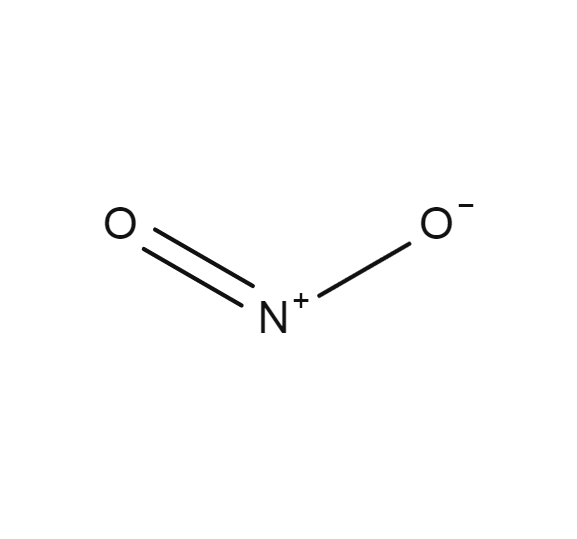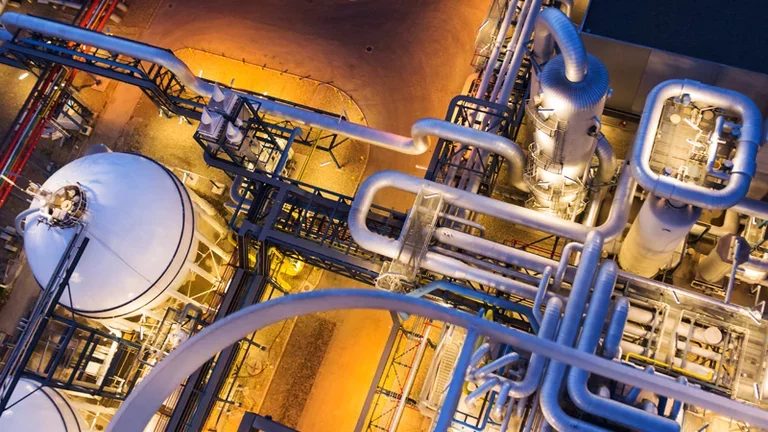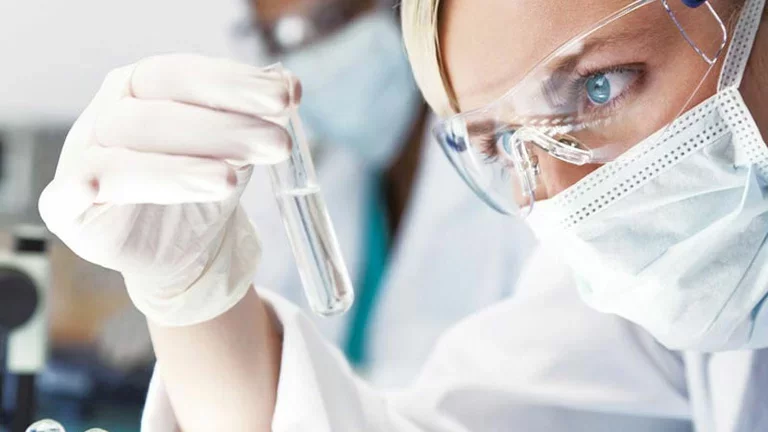
Nitrogen dioxide
- NO2
- CAS Number 10102-44-0
- UN1067 (gas)
Click & drag to move the 3D molecule
Liquid / Gas Volumes
Calculate the volume or mass of a quantity of gas or liquid
Liquid Phase
At boiling point at 1.013 bar
Gas Phase
In standard conditions (1.013 bar, 15°C)
Physical Properties
Molecule phase diagram showing the transition phases between solid, liquid and gas as a function of temperature and pressure
-
- Molar mass 46.006 g/mol
- Content in dry air /
-
Critical Point
- Temperature 158.00 °C
- Pressure 101.325 bar
- Density 557.71 kg/m³
-
Triple Point
- Temperature -11.25 °C
- Pressure 1.8728E-1 bar
Pressure 1.013 bar
| Latent heat of fusion (at melting point) | 318.437 kJ/kg |
| Melting point | - 11.25 °C |
Pressure 1.013 bar
| Boiling point | 21 °C |
| Latent heat of vaporization (at boiling point) | 828.51 kJ/kg |
| Liquid density (at boiling point) | 1447.58 kg/m3 |
Applications
Examples of uses of this molecule in Industry and Healthcare

Chemicals
Nitrogen dioxide is a strong nitrating or oxidizing agent in organic synthesis.

Laboratories & Research Centers
Nitrogen dioxide is used in calibration gas mixtures for petrochemical industry, environmental emission monitoring, industrial hygiene monitors and trace impurity analyzers
Safety & Compatibility
GHS03
Oxidising
GHS04
Gas under pressure
GHS06
Acute Toxicity
GHS05
Corrosive
Threshold of toxicity
| ILV-15min EU (at Patm and 293.15 K) | 1.91 mg/m3 or 1 ppm |
| ILV-8h EU (at Patm and 293.15 K) | 0.96 mg/m3 or 0.5 ppm |
| PEL USA OSHA (vol) | 5 [ceiling] ppm |
| VLEP 8h France (at Patm and 293.15 K) | 0.96 mg/m3 or 0.5 ppm |
| VLEP CT France (at Patm and 293.15 K) | 1.91 mg/m3 or 1 ppm |
Odor
Slightly irritating
Metals
| Aluminium | Not recommended |
| Brass |
Risk of stress corrosion cracking
Not recommended
|
| Monel | No data |
| Copper | No data |
| Ferritic Steel | Satisfactory |
| Stainless steel | Satisfactory |
| Zinc | No data |
| Titanium | No data |
Plastics
| Polytetrafluoroethylene | Satisfactory |
| Polychlorotrifluoroethylene | Satisfactory |
| Polyvinylidene fluoride | Satisfactory |
| Polyvinyl chloride |
Violent reaction (oxidation/burning)
Not recommended
|
| Ethylene tetrafluoroethylene | No data |
| Polycarbonate | No data |
| Polyamide |
Violent reaction (oxidation/burning)
Not recommended
|
| Polypropylene |
Violent reaction (oxidation/burning)
Not recommended
|
Elastomers
| Butyl (isobutene- isoprene) rubber |
Violent reaction (oxidation/burning)
Not recommended
|
| Nitrile rubber |
Violent reaction (oxidation/burning)
Not recommended
|
| Chloroprene |
Violent reaction (oxidation/burning)
Not recommended
|
| Chlorofluorocarbons | No data |
| Silicone |
Violent reaction (oxidation/burning)
Not recommended
|
| Perfluoroelastomers |
Violent reaction (oxidation/burning)
Not recommended
|
| Fluoroelastomers |
Violent reaction (oxidation/burning)
Not recommended
|
| Neoprene | No data |
| Polyurethane |
Violent reaction (oxidation/burning)
Not recommended
|
| Ethylene-Propylene |
Violent reaction (oxidation/burning)
Not recommended
|
Lubricants
| Hydrocarbon based lubricant |
Violent reaction (oxidation/burning) contamination of material
Not recommended
|
| Fluorocarbon based lubricant |
Contamination of material
Not recommended
|
Materials compatibility
Learn More
More information
Nitrogen dioxide is a major air pollutant resulting from the reaction between nitrogen monoxide and the oxygen from air.